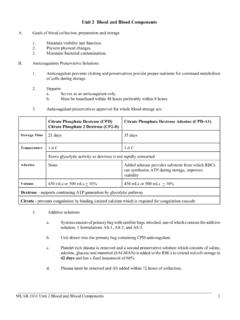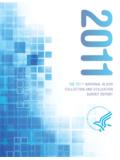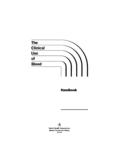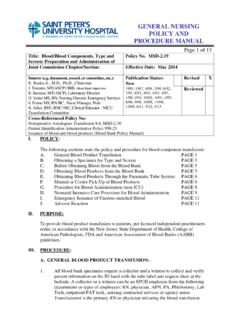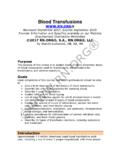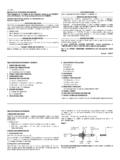Transcription of Minor Donor Permit and Information About …
1 BS 319RS (Rev. 3) Page 1 of 2 MAN100 For Parents and Students: Minor Donor Permit and Information About Donating blood Every day people like you need blood : students, teachers, family, and friends! And when blood is needed, blood must be there. The only source is generous volunteers like you! COMMON QUESTIONS About blood DONATION Q: Is blood donation safe? Does it hurt? A: Donating blood is safe. All materials are used once, and then discarded. You cannot get any infectious disease by donating blood . Most people feel fine after they give. The actual needle stick (venipuncture) hurts no more than a pinch. Q: How long will it take? A: The entire process takes About 60 minutes, including the interview before and refreshment time after donation; automated donations take longer.
2 For your safety, you must stay in the refreshment area at least 15 minutes following the donation. Q: How much can I give? A: Every Donor is evaluated individually with safety in mind! When you donate whole blood , one unit, About a pint is collected. Depending on your gender, height, and weight, you can give up to 2 units in an automated blood collection. For example, one Donor may be able to donate two units of Red blood Cells (RBC); another may donate one unit of Platelets and one unit of Plasma. blood Donor QUALIFICATIONS In general, volunteer blood donors must be 16 or older and in good health. blood Donation: The Process Whole blood Donation blood is collected from an arm vein into a bag specially designed to store blood .
3 Typically, each unit is separated into multiple components, usually RBCs and Plasma. Whole blood donation is the most common way to donate blood . We also use special machines for automated blood collection. Automated blood Collection Methods With automated equipment, the blood center can collect the exact components that patients need. blood is collected from an arm vein and passed through an apheresis instrument that separates the blood into its components. During donation, a small amount of anticoagulant (citrate) is added to the blood to prevent clotting. After the targeted component(s) is/are collected, the remainder of the blood is returned to the Donor . The Donor may receive saline solution to help replace fluid lost during the collection.
4 The body naturally replaces the donated components: plasma within several hours, platelets within 24 hours, and red cells in About 56 days (112 days for 2-unit Red blood Cell donation). The number of white blood cells lost is small. Some Potential Side Effects Serious complications are rare. However, as in any medical procedure, there are certain risks. Potential side effects of both whole blood and automated blood collection include fainting, dizziness, nausea, vomiting, bruising or redness in the area of the venipuncture, and iron deficiency in individuals making 3 or more donation a year. More serious reactions may include seizures and, rarely, nerve injury in the area of the venipuncture. While a small proportion of blood donors have adverse reactions (overall reaction rate of ), donors aged 16 to 22 do experience a higher prevalence of reactions ( About 5%).
5 To reduce the likelihood of a reaction, the blood center evaluates eligibility for younger donors based on weight and height to determine blood volume. The chart above indicates whether your blood volume is sufficient for you to donate. Please review it carefully. Other Height/Weight Restrictions for donors Age 16-22 Eligibility is Based on Estimated Total blood Volume Males between 16 and 22: You must be at least 5' tall and weigh at least 110 pounds. Females between 16 and 22: If you weigh at least 110 but are shorter than 5'6", please refer to this chart*: Females who are: 4'10" 4'11" 5' 5'1" 5'2" 5'3" 5'4" 5'5" Must weigh: 146 142 138 133 129 124 120 115 *Shorter people must weigh more to achieve a 3500 mL blood 319RS (Rev.)
6 3) Page 2 of 2 MAN100 possible complications include fatigue, decreased exercise tolerance for 3-5 days and, very rarely, allergic reaction, shortness of breath, chest pain, and decreased blood pressure. In addition, during automated blood collections some common side effects that are easily resolved are due to the anticoagulant and include numbness and tingling sensations, muscle cramping, and chilliness. Less common complications include hemolysis and air embolism. If you have any questions, please contact the blood center. STUDENTS: Take these steps on the day of donation for a good blood donation experience. If you are 16 or 17, bring this signed Minor Donor Permit when you donate. The signature block is below. BRING ID containing name and one of the following: birth date, blood center Donor number, or photo.
7 You must pass the physical and health history examination given prior to donation. If you have any questions regarding your eligibility, please check with your blood Drive Coordinator or the blood center. Eat a healthy meal before donating, even if you do not normally eat three meals a day. Drink 16 ounces of fluid 10-30 minutes before donating (soda, coffee, and tea don t count!). PARENTS/GUARDIANS: Help your student have a good blood donation experience. The Day Before Donation: Make sure your student eats a salty snack, like chips or pretzels, and has a meal that is higher in sodium, such as fast food, canned soup, pizza, etc. Physicians recommend this because donors lose About a gram of sodium during donation.
8 Replacing some of that sodium ahead of time makes donors thirsty. Being well-hydrated helps donors maintain blood volume and can prevent dizziness or fainting. The Day of Donation: Make sure your student has a light meal before donating, and encourage your student to carefully follow our directions. Our staff are specially trained to respond to Donor reactions. We will: Give your student reading material and instructions on how to have a safe, comfortable blood donation. Teach your student muscle tensing exercises to use during and after donation. Provide a sports drink or another beverage and a salty snack. Tell your student to spend at least 15 minutes in our refreshment area. Our blood center participates in research to improve blood safety.
9 We may use your Donor history Information and a sample of your blood , in a confidential manner, for blood safety research, as described in the accompanying research Information document(s). We are required to get parental consent for both 16- and 17-year old donors for this research. For more Information About this research or blood donation, go to A sample from each blood donation will be tested for HIV (AIDS), HTLV, hepatitis, syphilis, and other infectious agents as required by regulations. These tests are performed to protect the patients who receive blood . Positive test results will be disclosed as authorized by law, and the Donor will be notified. In some cases, blood center staff may need to discuss test results with the Donor .
10 Per California law, it is the Donor s decision whether his/her parents are to be included in that discussion. Please be sure that you and your student have read the Information provided. If required by your state or school, your student must bring this signed Minor Donor Permit form in order to donate. I give my permission for my student to donate and for that donation to be tested as explained above. Parent/Guardian: Please complete all of the following using black or blue INK. Student s Name: (Print) Parent/Guardian Name: (Print) (Signature) Date of Approval: (Month/Day/Year) Phone # where Parent/Guardian can be reached: Zika Virus Research Information BS 757 (Rev. 3) Page 1 of 2 Sponsor / Study Title: Hologic, Inc.


